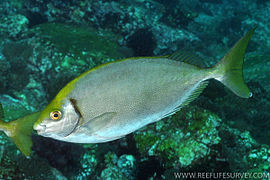Breizacanthus is a genus in Acanthocephala.
Euzetacanthus is a genus in Acanthocephala.
Multisentis is a monotypic genus of acanthocephalans. It contains a single species, Multisentis myrmecobius , parasite of the numbat from which it derives its species name. It was found in south-western Australia.
Neoncicola is a genus of parasitic worms containing nine species and belongs to the family Oligacanthorhynchidae.
Floridosentis is a genus in Acanthocephala.
Cathayacanthus is a genus in Acanthocephala.
Pyriproboscis is a monotypic genus of acanthocephalans. It is the only genus in the family Pyriprobosicidae.
Southwellina is a genus in Acanthocephala.
Cavisoma is a monotypic genus of acanthocephalans containing a single species, Cavisoma magnum, that infests animals.
Caballerorhynchus is a monotypic genus of acanthocephalans containing a single species, Caballerorhynchus lamothei, that infests animals.
Rhadinorhynchoides is a monotypic genus of acanthocephalans containing a single species, Rhadinorhynchoides miyagawai, that infests animals.
Neorhadinorhynchus is a genus in Acanthocephala.
Gracilisentis is a genus in Acanthocephala.
Pandosentis is a genus in Acanthocephala.
Brentisentis is a genus in Acanthocephala.
Dispiron is a genus in Acanthocephala belonging to the family Neoechinorhynchidae.
Octospiniferoides is a genus in Acanthocephala belonging to the family Neoechinorhynchidae.
Owilfordia is a genus of Acanthocephala belonging to the family Plagiorhynchidae.
Paulisentis is a genus in Acanthocephala belonging to the family Neoechinorhynchidae.
Paralongicollum is a genus in Acanthocephala, the thorny-headed worms, also known as spiny-headed worms.



